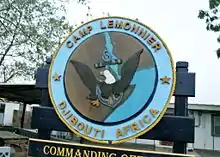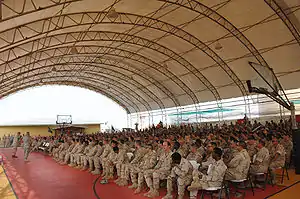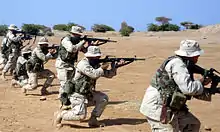Camp Lemonnier
Camp Lemonnier is a United States Naval Expeditionary Base,[1] situated next to Djibouti–Ambouli International Airport in Djibouti City, and home to the Combined Joint Task Force – Horn of Africa (CJTF-HOA) of the U.S. Africa Command (USAFRICOM).[2] It is the only permanent U.S. military base in Africa.[3][4] The camp is operated by U.S. Navy Region Europe, Africa, Southwest Asia; CJTF-HOA is the most notable tenant command located at the facility as of 2008.
| Camp Lemonnier | |||||||
|---|---|---|---|---|---|---|---|
| Ambouli, Djibouti City in Djibouti | |||||||
 A US Marine Corps AV-8B Harrier landing at Camp Lemonnier in 2014 | |||||||
 | |||||||
 Camp Lemonnier Location in Djibouti | |||||||
| Coordinates | 11°32′37″N 43°08′55″E | ||||||
| Type | US military base | ||||||
| Site information | |||||||
| Owner | Government of Djibouti (leased to the US) | ||||||
| Operator | United States Navy | ||||||
| Controlled by | Navy Region Europe, Africa, Central | ||||||
| Condition | Operational | ||||||
| Website | Official website | ||||||
| Site history | |||||||
| Built | 2002 | ||||||
| In use | 2002 – present | ||||||
| Garrison information | |||||||
| Current commander | Captain David Faehnle | ||||||
| Garrison | Combined Joint Task Force-Horn of Africa | ||||||
| Airfield information | |||||||
| Identifiers | IATA: JIB, ICAO: HDAM | ||||||
| Elevation | 15 metres (49 ft) AMSL | ||||||
| |||||||
| Airfield shared with Djibouti–Ambouli International Airport | |||||||
Camp Lemonnier was originally established as garrison for the French Foreign Legion. The base was leased by Djibouti to the United States in 2002, along with the right to use the neighboring airport and port facilities. The base supports Operation Enduring Freedom – Horn of Africa (OEF-HOA) and is the centerpiece of a network of around six U.S. drone and surveillance bases stretching across the continent.[4][5] The latter air bases are smaller and operate from remote hangars situated within local military bases or civilian airports. Due to its strategic location, Camp Lemonnier also serves as a hub for aerial operations in the Persian Gulf region.[4]
Djibouti is strategically located by the Bab-el-Mandeb Strait, which separates the Gulf of Aden from the Red Sea and controls the approaches to the Suez Canal. As a result, the country hosts many other foreign military bases, including a Chinese naval base, a French airbase, an Italian Support Base and a Japanese base. Unlike French troops, who are allowed to enter Djibouti city and interact with the locals, US troops may only leave Camp Lemonnier by special permission, and most of Djibouti City is off limits.[6][7]
History

Camp Lemonnier is located in the town of Ambouli on the southern side of the Djibouti–Ambouli International Airport, between the runway overflow areas and a French military munitions storage facility. After use by the French Foreign Legion, the facility was operated by the Djibouti Armed Forces.
Lemonnier originally belonged to the French military, and was named after General Émile-René Lemonnier. Commander of the 3rd Brigade of the Tonkin Division, led with fierce energy the resistance to the Japanese coup d'état in French Indochina. In 2009, after years of misspelling, the U.S. Navy officially changed the camp's name to properly reflect the spelling of General Lemonnier's name.[8]
Following the September 11, 2001 attacks, the U.S. decided to increase counter-terrorism efforts. At first, this was limited to focused attacks, but in 2002 the U.S. government realized that to reduce extremism would require long term engagement with the local governments and populations. As a result, it established the Combined Joint Task Force-Horn of Africa to conduct stability operations in the area. In November 2002, the CJTF-HOA staff, a Marine-based organization, arrived off the coast of Djibouti aboard USS Mount Whitney, a naval command ship. Djiboutian workers were instrumental in preparing the newly renovated 88-acre (360,000 m2) camp for movement of the CJTF headquarters ashore. More than 1,200 local and third-country national construction and support personnel currently work at the camp. KBR administers the contract for facilities and support operations for the camp.
A Marine Corps FAST team was the initial force to occupy Camp Lemonier in June 2002, providing security while Army Special Forces Logistics specialists (SOT-A) planned the development to receive more forces. Initial Command and Control was established under SOCCENT by a US Air Force Special Operations command element. The[9] initial US combat forces started with Air Force MC-130s and MH-53s who redeployed from Jacobabab, Pakistan, followed shortly by 7th SFG soldiers and an Army Tank Support Battalion for base support. While the intent was to move ashore, the Camp Lemonnier facilities which had not been in use for several years were in a state of disrepair. Some buildings were concrete shells and had been stripped of interior fixtures, pipes and wiring, while the roofs of several structures had collapsed. Goats roamed the property and birds had taken roost in several of the abandoned structures. The former swimming pool had been used as a trash dump. Some buildings that were closer to the Djiboutian Air Force controlled side of the airport were in better shape and required minimal renovation. As a result, the CJTF-HOA staff remained aboard the USS Mount Whitney as the U.S. Army (Bravo Company, 46th Engineer Battalion (CBT)(HVY)) began renovations. (Camp Physical Security was first established by Marines from 2D Fleet Anti-Terrorism Security Team (FAST Co) and was handed over to the 551st Military Police Company, 101st Airborne Division.) This involved building new concrete pads, maintenance facilities and living areas. In May 2003, Camp Lemonnier was livable and CJTF-HOA transitioned from the Mount Whitney to the camp. The pool was cleaned, refurbished, and opened in spring of 2003.
Combined Joint Task Force-Horn of Africa (CJTF-HOA) began moving all headquarters personnel and equipment from its flagship, USS Mount Whitney, in the Gulf of Aden, into facilities at Camp Lemonnier on 6 May 2003.
In early July 2006, the U.S. and Djiboutian governments also announced that a lease agreement had been signed to expand Camp Lemonnier from 88 acres (360,000 m2) to nearly 500 acres (2 km2). The term of the lease was for five years, with options to renew. As part of the lease and expansion, physical improvements to the camp included fencing, additional billeting to replace existing tents, and compliance with various U.S. force protection standoff requirements.
On 1 July 2006, the U.S. Marine Corps turned over responsibility for Camp Lemonnier to the U.S. Navy in a brief change of command ceremony. U.S. Navy Captain Robert Fahey assumed command of Camp Lemonnier from U.S. Marine Corps Colonel Gerard Fischer.[10]
In January 2007, it was announced Camp Lemonnier would be expanded from 97 acres (0.39 km2) to nearly 500 acres (2.0 km2).[11] As part of the process of moving Lemonnier from an "expeditionary" base to a long term facility, the camp built a billeting area with rows of Containerized Living Units (CLUs) with concrete sidewalks and gravel roads.[12] As the CLU area expanded, the camp population moved from tents into the more durable berthing facilities.[13]
.jpg.webp)
Transfer to USAFRICOM
On 1 October 2008, responsibility for the task force was transferred from the United States Central Command (USCENTCOM) to United States Africa Command (USAFRICOM) as the latter assumed authority over the African theater of operations.[2]
By 2009, the base began expansion again. According to OSGEOINT, the base received a parallel taxi-way and a new auxiliary support apron. In the following year (2011), open source satellite imagery showed Camp Lemmonier with a new drone apron supporting the RQ/MQ-1 Predator.[14] Furthermore, Camp Lemmonier has been described by The Economist as "the most important base for drone operations outside the war zone of Afghanistan", with drones conducting missions in adjacent Yemen and Somalia.[15]
Neville wrote that "..in a separate secure compound within the camp, much like the SOF enclave in Bagram, are an estimated 300 JSOC personnel. There personnel comprise special operators, imagery and intelligence analysts, an d a dedicated UAV cell. The UAV cell is commanded by a JSOC Major and tasks a flight of eight MQ-1 Predators conducting operations over Somalia, Mali, and Yemen. The Predators [have] been carrying out strike and surveillance missions from Camp Lemonnier since late 2010."[16]
In October 2011, a squadron of USAF McDonnell Douglas F-15E Strike Eagles arrived at the base. They have flown numerous combat missions into Yemen in support of both Yemeni government forces and unilateral strikes directed by JSOC and the CIA targeting cells. Along with the UAVs and F-15Es, surveillance flights are conducted by U.S. Air Force Special Operations Command U-28As, that are outfitted with sophisticated signals intercept equipment and optical sensors, which can provide real-time intelligence for ground operators.[17] Prior to that, both CIA and JSOC had used the base as a temporary forward location for Predator and Reaper sorties.
On 25 January 2012, US officials confirmed that US Navy SEALs had rescued two foreign hostages in Somalia, an American woman and Danish man, taking them to Camp Lemonnier.[18] Demining workers, the captives had been abducted on 25 October 2011 in the north-central Galkayo area, allegedly by gunmen operating on behalf of a private source who threatened to sell them to Al-Shabaab if their demands were not met.[19][20][21]
As of May 2013, the US had prepared plans for a $1.4 billion expansion of the base and to increase its special forces there to more than 1,000.[22]
In 2013, the Predators and Reapers operating from Lemonnier were moved to "a remote desert airstrip" [later identified as Chabelley Airport]. The move increased operational security and allayed local fears after a UAV and its AGM-114 Hellfire missile crashed in a Djibouti suburb.[17]
In May 2014, U.S. President Obama and Djiboutian President Guelleh agreed on a 20-year extension of the American lease, at $63 million a year in rent – about double its previous rate. The US is in the process of expanding the base and plans to spend $1.4 billion upgrading the facility over the next two decades.[23][24]
In 2017, China opened a base nearby, the Chinese People's Liberation Army Support Base in Djibouti.[25] In May 2018, the United States Air Force said military grade lasers had been aimed at the eyes of its pilots and the incidents had originated on the Chinese base.[26][27] China denied that they were the source of the lasers, stating that they abide by international law.[28]
Base of Operations

Camp Lemonnier became the hub for black and white SOF operations into nations such as Somalia and Yemen. Also based there is the SOCCE-HOA (Special Operations Command and Control Element-Horn of Africa) – which commands all SOCOM units assigned to training or operational missions in the region including elements of JSOTF-TS (Joint Special Operations Task Force-Trans Sahara) and Naval Special Warfare Unit 10.[16] It also supervises a rotational detachment of US Army Special Forces which conducts foreign Internal Defence training in counterinsurgency in Djibouti.
Tenant commands
Ground forces
Camp Lemonnier is operated by Commander, Navy Region Europe, Africa, Southwest Asia, which is responsible for its expansion, upkeep, and logistics support. Tenant units include the U.S. Marine Security Forces which provides the camp's external security, the CJTF-HOA commander and staff, a U.S. Navy Seabee battalion which conducts water-well drilling operations, U.S. Army units which provide additional security, military training, and Civil-military operations support, and several aircraft detachments.
Past tenant units have included the U.S. Marine 8th and 9th Provisional Security Force (PSC), U.S. Army 2nd Battalion, 18th Field Artillery Regiment, U.S. Army 1st Battalion, 65th Infantry Regiment, U.S. Army 1st Battalion, 16th Infantry Regiment, U.S. Air Force First Red Horse Group, U.S. Army 2nd Battalion, 137th Infantry Regiment, U.S. Army 3rd Squadron, 124th Cavalry Regiment, and U.S. Army 2nd Battalion, 138th Field Artillery Regiment.
Aviation units
The 449th Air Expeditionary Group is U.S. Air Force component to CJTF-HOA and is assigned to Camp Lemonnier. The 449th AEG is currently composed of HC-130P Hercules COMBAT KING or HC-130J COMBAT KING II aircraft assigned to the 81st Expeditionary Rescue Squadron and pararescuemen assigned to the 82nd Expeditionary Rescue Squadron.[29] While deployed the group performed both combat and civil search and rescue missions.[30]
Aircraft detachments include a U.S. Marine heavy-lift helicopter (CH-53) detachment, a U.S. Marine assault-support MV-22 Osprey detachment, a U.S. Navy P-8 Poseidon detachment (technically a part of the US Navy's 6th Fleet – Commander Task Force 67[31]), USAF aircraft include HC-130P COMBAT KING or HC-130J COMBAT KING II, HH-60G Pave Hawk, C-130J Hercules and, at times, a C-17 Globemaster III detachment.
Other
Customs inspections for exotic organisms is the responsibility of the Navy Logistics team.[32]
See also
References
- "Introduction to MARCENT". United States Marine Corps. May 2006. Archived from the original (PPT) on 25 October 2007. Retrieved 9 February 2007.
- "Africans Fear Hidden U.S. Agenda in New Approach to Africom". Associated Press. 30 September 2008. Archived from the original on 2 April 2013. Retrieved 30 September 2008.
- Contorno, Steve (12 June 2014). "Hillary Clinton says in memoir that there's very little U.S. military presence in Africa". PolitiFact.com. Retrieved 3 July 2014.
- "U.S. expands secret intelligence operations in Africa". The Washington Post. 13 June 2012. Retrieved 5 April 2015.
- "Remote U.S. base at core of secret operations". The Washington Post. 26 October 2012. Retrieved 5 April 2015.
- Jacobs, Andrew; Perlez, Jane (25 February 2017). "U.S. Wary of Its New Neighbor in Djibouti: A Chinese Naval Base".
- Pieper, Dietmar (8 February 2018). "Geopolitical Laboratory: How Djibouti Became China's Gateway To Africa". Spiegel Online.
- Aris, Ben (18 April 2019). "Playing real Risk – Russia vs US". bne IntelliNews. Retrieved 19 December 2022.
- USSOCOM Lessons Learned Document 006-2002, JTF-DJ
- "Release #121: U.S. Navy Assumes Command of Camp Lemonier". United States Navy. 3 July 2006. Archived from the original on 28 November 2006. Retrieved 7 February 2007.
- "Camp Lemonnier, Djibouti, expands both in size and job opportunities". CJTF-HOA. 23 January 2007. Archived from the original on 2 July 2007. Retrieved 7 February 2007.
- Welcome to Camp Lemonnier, Djibouti Archived 30 March 2012 at the Wayback Machine
- Camp Expansion Moves Ahead, United States Central Command Archived 6 April 2008 at the Wayback Machine
- "Djibouti: RQ/MQ-1 Presator Deployment Imagery Confirmation". OSGEOINT. 23 February 2012. Retrieved 23 February 2012. # REGISTRATION NEEDED #
- "Unmanned aerial vehicles: Death from afar". The Economist. 3 November 2012. Retrieved 30 December 2012.
- Neville 2015, p. 281.
- Neville 2015, p. 282.
- "Somalia: Western hostages freed in US military raid". BBC News. 25 January 2012. Retrieved 25 January 2012.
Two foreign aid workers kidnapped in Somalia three months ago have been freed in a rare US military raid.
- Impossible Odds: The Kidnapping of Jessica Buchanan and her Dramatic Rescue by SEAL Team Six
- Somali elders stand up against kidnapping of aid workers Archived 1 October 2013 at the Wayback Machine
- Aid workers kidnapped in Somalia are alive and well Archived 7 March 2012 at the Wayback Machine
- Containers—and containing dissent Archived 1 May 2016 at the Wayback Machine
- "Djibouti, a safe harbour in the troubled Horn of Africa". thenational.ae. 15 October 2015.
- "US secures 10-year deal for Djibouti base". 6 May 2014.
- Shearer, Andrew (9 May 2018). "How China's Laser Attacks on the U.S. Military Could Cause a Serious Conflict". Fortune. Retrieved 9 May 2018.
- Brennan, David (3 May 2018). "Pilots Flying Over Its Base in Djibouti". Newsweek. Retrieved 9 May 2018.
- "US accuses China of pointing lasers at its pilots from Djibouti base". BBC News. 4 May 2018. Retrieved 26 November 2021.
- "China denies using lasers on US aircraft in Djibouti". The Washington Post. Associated Press. 4 May 2018. Archived from the original on 4 May 2018. Retrieved 9 May 2018.
- USAFE/AFRICA Public Affairs Office, USAFE Factsheet, U.S. Forces Africa Archived 2 April 2015 at the Wayback Machine 8/27/2002 (retrieved 26 May 2013)
- Drake, Corey 449th Air Expeditionary Group Changes Hands in Djibouti Archived 4 March 2016 at the Wayback Machine 2 March 2009 (retrieved 26 May 2013)
- Commander Task Force 67 Archived 3 March 2016 at the Wayback Machine
- "CLDJ's Customs Team Inspects for Harmful Pests". Defense Visual Information Distribution Service (DVIDS). 4 March 2021. Retrieved 12 October 2022.
- Neville, Leigh (2015). Special Forces in the War on Terror (General Military). Osprey Publishing. ISBN 978-1-4728-0790-8.

